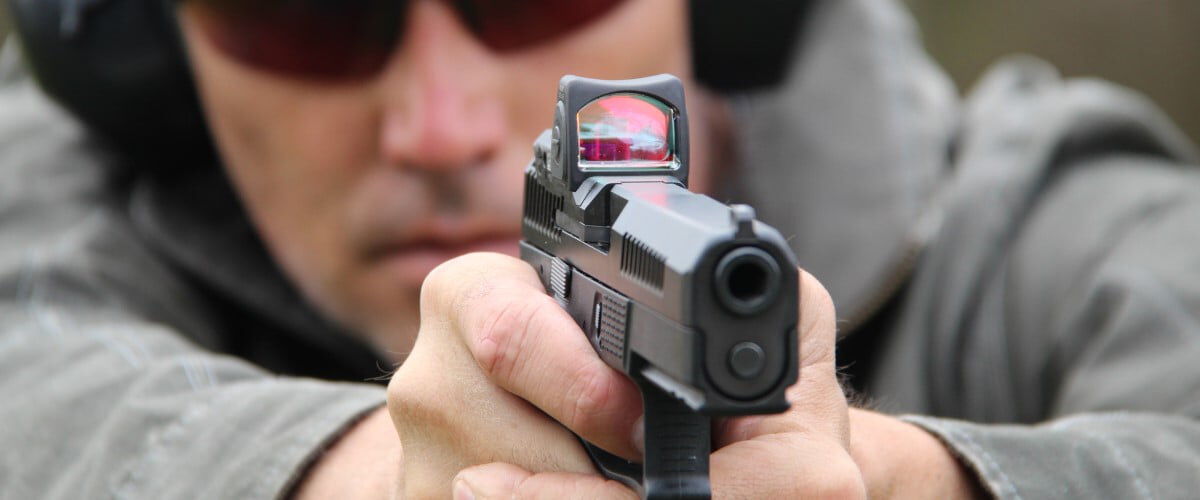
Top pistol shooters are amazing athletes, and watching them draw, fire, and transition between targets with a handgun is unforgettable. While most of us will never achieve the level of competitive success on par with these shooters, it’s possible for every handgun owner to improve their split times.
Of course, faster split times are essential to win matches. But even if you’re never going to compete and simply shoot recreationally or carry a handgun for self-defense, you can improve your split times (without sacrificing accuracy) with a few simple drills.
Get To Know The Gun
The first step toward improving your split times is getting to know your pistol, and the best way to do this is with dry-fire drills. Making certain the magazine and chamber are unloaded, aim the pistol at a safe target and press the trigger rearward. Did the sight move? If so, odds aren’t you aren’t simply squeezing your trigger finger but rather your entire hand. This is evidenced by seeing the gun “roll” with the shot. Generally, the sight picture will dip down and left for right-handed shooters and down-right for lefties. This is a clear indication that you are not pulling straight back on the trigger.
Red dots exaggerate this movement, and that’s why they make a great training tool. If you’ve centered the dot on the target, you’ll immediately notice any movement of the dot. Repeat the drill until you are delivering a smooth, rearward trigger press without shifting your sight picture.
The dry-fire drill is also an appropriate time to practice trigger reset, which means allowing the trigger to move far enough forward to once again be ready to fire. With striker-fired guns you’ll need to cycle the action (but not fully to slide lock) before resetting the trigger, but once you do so you should be able to ease the trigger forward until you feel the reset and hear an audible click. The trigger has reset.

Various instructors teach the finer points of trigger reset differently. Some want shooters to continue this drill very slowly, and other want shooters to rapidly release the trigger to the reset point to fire the next shot. Ideally, you’ll be able to release the trigger just enough to fire the next round quickly without having to completely move your finger from the trigger. With new guns, I like to slowly reset the trigger and get a feel for the reset before speeding up the shots, but maximum speed will only come when you can fire, maintain sight picture and proper trigger pull, release the trigger far enough to reset, and press the trigger again, always remaining mindful of sight picture and ensuring you aren’t getting so aggressive that you begin to rotate the pistol and lose accuracy.
Split Times—What’s Good?
Once you’ve become comfortable with dry-fire drills you can move to live fire. I do most of my shooting with target ammunition such as Speer Lawman. These affordable target loads have moderate recoil and consistent performance. Many cheap 9mm loads are stuffed with dirty powder and use poor cases, but Lawman works effectively without costing a fortune, and that’s why I use it for training. I’m not interested in clearing jams and cleaning grime out of my guns.
Look up pistol split times anywhere on the internet and you’ll see .12 to .15 second is very good between accurate shots, and a few shooters even flirt with .10-second splits. Don’t let these times dissuade you. A really good runner can post a sub-15-minute 5K time, but unless you’re a gifted athlete and train religiously you won’t hit that mark. The same applies to shooting splits. I believe with ample, appropriate training the average person can muster .25-inch splits for aimed shots. But if you’re at .4-second for splits when you start, don’t fret. This is your race, and you’re trying to beat yourself, not a USPSA Grand Master.

To get really accurate split times, you need a shot timer. It doesn’t have to be fancy, and functional shot timers (also known as split timers) cost around $120. That money will buy a couple hundred rounds of 9mm practice ammo so I understand not wanting to fork over the cash. However, if you’re serious about improving split times, a shot timer is important.
Lock In
Once you’ve worked on the above drills and have shaved time from your splits, you may begin to improve split times while transitioning between targets. One key element to fast, accurate transitions is locking the upper body and rotating from the hips. Whether you use an isosceles or Weaver-style stance matters little here, but you must try to keep the upper body fixed. The head, shoulders and upper torso should all pivot on the hips.
Make certain your footing is stable before beginning transition work. I want to be planted with feet flat and shoulder width (or so) apart. In this way the lower body is planted, too, allowing the left-right motion to come through the hips. This way you’ll maintain shooting position as you progress from one target to the next.
Now Practice
Being lectured about shooting practice is the equivalent of having your doctor tell you to eat more vegetables and exercise, but both are sound advice. Improved pistol performance comes after several hundred rounds for most shooters, and the skills you’ll learn will take time to become hard-wired into your subconscious. You won’t need to think about proper trigger pull, sight picture, and quick resets and follow-ups because they become second nature.
If you need another reason to train a lot, let me offer a practical piece of advice. Most of us own a handgun, at least tangentially, to defend ourselves at home and in public places. Thankfully, many of us will never need to use our firearm to save ourselves or our loved ones. Some will. If I am ever faced with those circumstances, I want every advantage available to me, and right at the top of that list is practice. Can I shoot quickly and accurately? Can I move and shoot or transition from one target to the next? Do I know my gun well enough that I can make it function properly at the worst and most traumatizing moments? These considerations might seem dramatic, but only to those who have never faced those questions first-hand when seconds mean survival.

Gold Dot Carry Gun
Compact pistols have never offered this level of protection. We’ve built upon the law-enforcement proven Gold Dot G2 bullet, optimizing the design and loading to provide superior feeding, ballistics and terminal performance through compact concealed handguns.
Buy Now